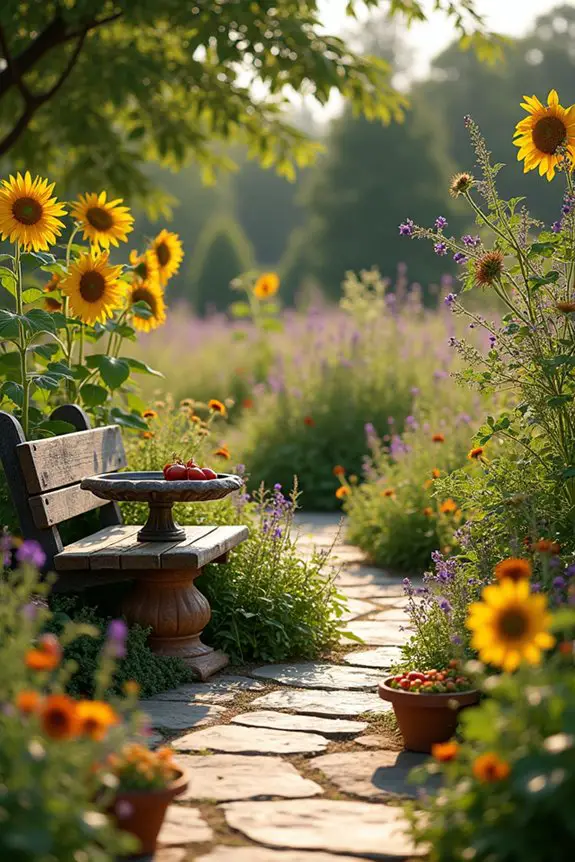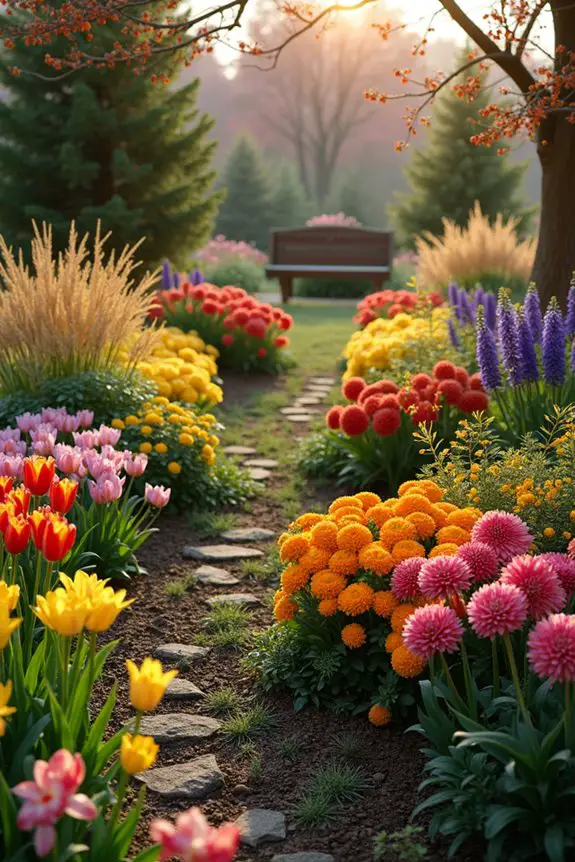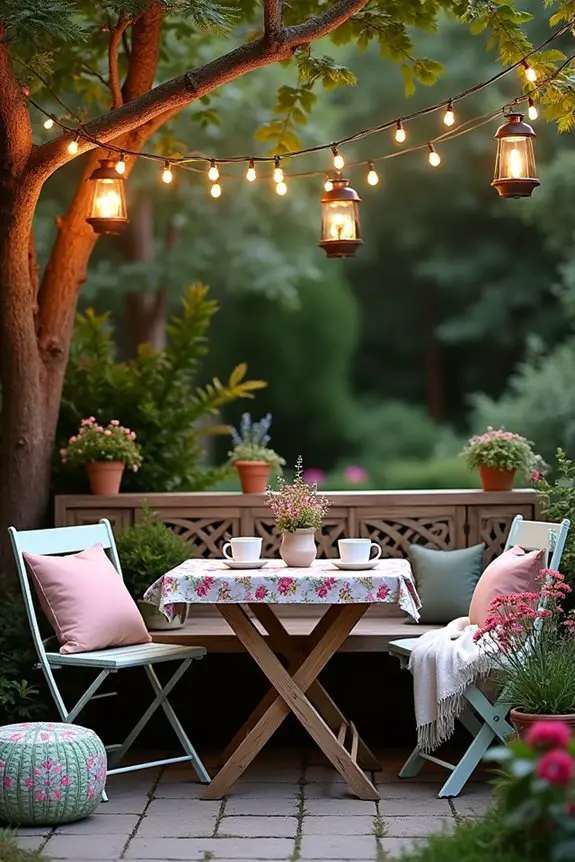So, you wanna create your dream garden space, huh? It can be a little intimidating, but don’t worry—you’re not alone. Imagine this: cozy nooks, vibrant blooms, and paths that make you feel like you’re stepping into a storybook. From that eco-friendly plant selection to those quirky birdbaths, there’s a lot to think about. Ready to turn your outdoor area into a magical retreat? Let’s explore some fantastic ideas that’ll spark your inspiration.
The Designs: Eco-Friendly Plant Selection
When picking plants for your eco-friendly garden, think about fire-resistant choices that won’t just save your plants but could also protect your home.
You’ll also want to attract those busy pollinators, so think colorful flowers that sing to bees and butterflies alike.
Using textures in your plant selection, paired with a clever water-saving strategy, can make your garden not only beautiful but super smart too.
1. Fire-Resistant Plant Strategy
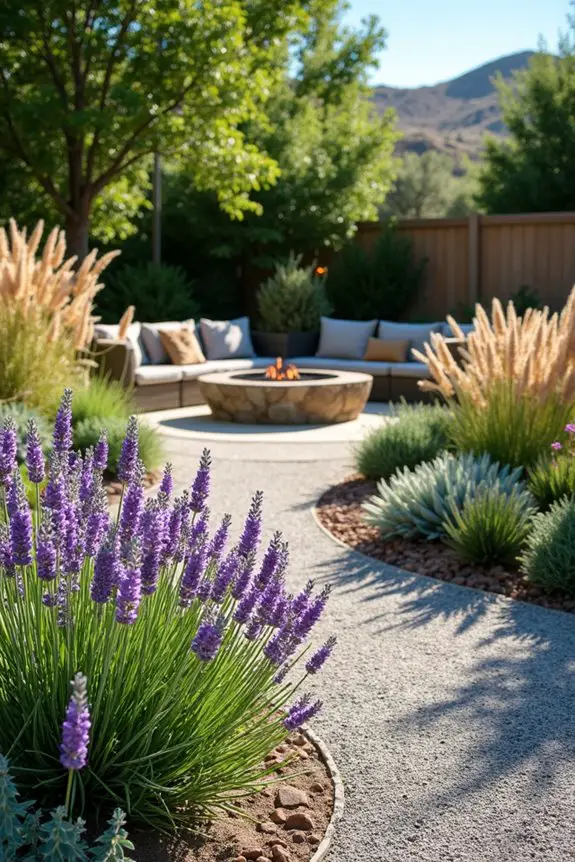
When designing a garden in a fire-prone area, selecting the right plants is essential. It’s not just about aesthetics; it’s about creating a safe and functional outdoor space that can stand up to the elements, while still looking beautiful. Imagine strolling through your garden, surrounded by vibrant, fire-resistant plants that give you peace of mind and a sense of tranquility.
Start with selecting plants that are naturally resistant to flames, like lavender, sage, and manzanita. These plants have a foot in both worlds; they not only look stunning but also thrive in dry conditions. It’s like having a garden that’s both a fortress and a retreat, ready to take on the heat of summer while still looking cool and stylish.
Pairing these plants with some well-placed gravel or stone pathways can also help create a barrier that slows down flames.
Remember that plant placement is key! Create clusters of fire-resistant plants while leaving space between them. This not only enhances the visual appeal but also reduces the chances of fire spreading. You want your garden to be inviting, not like a packed concert where everyone’s too close for comfort. Ever tripped in a crowded hallway? No fun.
Don’t forget to take into account the size and growth habit of your plants. Taller specimens, like ornamental grasses, can act as a lovely backdrop while minimizing clutter closer to the ground. Think of them as the well-dressed guests at your garden party—tall, elegant, and always classy.
And let’s create an inviting vibe. Incorporate seating areas with fire pits made from non-combustible materials like stone or metal. Imagine gathering around with friends, sharing stories while knowing your garden doubles as a safe haven.
It doesn’t have to feel like a boring safety zone; it can be dynamic, stylish, and eco-friendly all at once. With these strategies, your outdoor space can be a visually striking oasis that prioritizes both beauty and safety. So, go ahead—create that fire-smart garden that brings you joy and peace of mind.
2. Pollinator-Friendly Plant Selection

When it comes to creating a pollinator-friendly garden, you’re tapping into something that not only looks beautiful but also plays a crucial role in our ecosystem. Think of it as your little piece of paradise where bees, butterflies, and hummingbirds can thrive, all while adding a splash of life and color. Plus, who wouldn’t want to sip their morning coffee with nature buzzing around them?
First off, choose native plants that attract these little garden helpers. Plants like coneflowers, black-eyed Susans, and bee balm aren’t only eye-catching but also serve as welcoming beacons for pollinators. It’s like setting out a buffet just for them—no fancy table settings required. These plants have evolved to thrive in your specific climate, reducing the need for extra watering and maintenance, which means you get to spend more time enjoying your garden and less time stressing about it. Additionally, using a soil thermometer garden can help ensure your plants are in optimal growing conditions.
Now, let’s talk about variety. Mixing different types of plants with staggered bloom times creates a continuous banquet for pollinators throughout the seasons.
Imagine a garden that always has something buzzing and blooming, from spring to fall. Plant some flowers like lavender or thyme alongside those show-stopping sunflowers, and you’ve got a gorgeous mélange that’s irresistible to bees and butterflies alike. It really does feel like throwing the ultimate garden party every day.
Don’t forget about layering! Grouping plants in clusters, taller ones in the back and shorter in the front, makes your garden visually striking while giving pollinators easy access to all those tasty blooms.
Picture it like seating arrangements at that party—everyone gets a view, and there’s room to mingle. Plus, this setup can help maximize sunlight, which your plants will thank you for.
Lastly, consider adding some water features. A simple shallow dish filled with pebbles and water can be a revitalizing oasis for your pollinators.
It’s like providing them with their own spa day, right in your backyard. Watching them flit around is such a joyful moment; trust me, you’ll want to take a million pictures (just don’t be that person who interrupts their ‘me time’). Plus, a hand rake can be an essential gardening tool for maintaining the tidiness of your pollinator garden.
3. Textured Layering Techniques
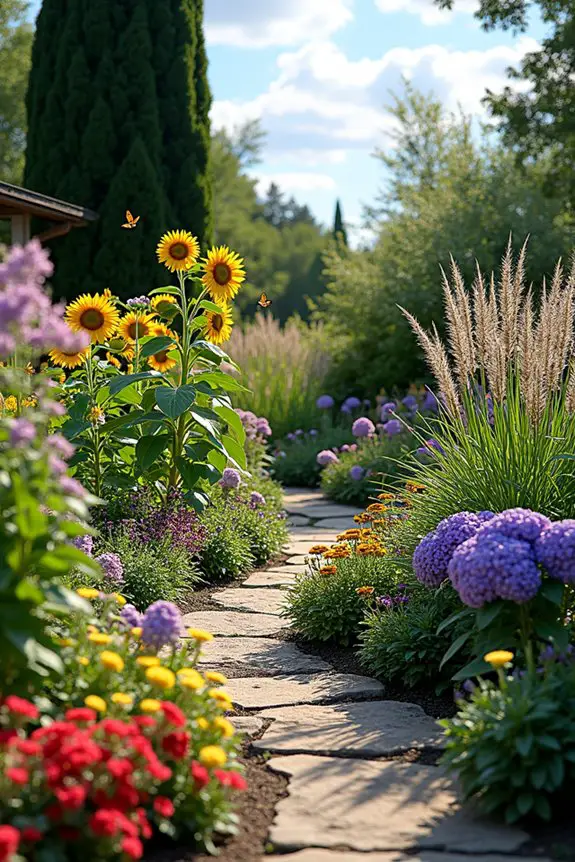
When it comes to building a stunning garden, it’s all about layering textures to create depth and interest. Think of your garden as a multi-dimensional canvas where every plant plays a role in the overall masterpiece. We all love those photos of lush gardens that have that rich complexity, right? Well, textured layering techniques not only elevate the visual appeal but also invite various wildlife, making your garden a bustling hub of life and beauty.
Start by choosing plants with different leaf shapes and sizes. For instance, while the ruffled leaves of lamb’s ear contrast wonderfully with the spiky forms of ornamental grasses, they also mix seamlessly to create an inviting atmosphere. It’s like inviting folks to a dinner party—everyone brings something different to the table.
Plant taller species, like asters or sunflowers, in the back, and let the shorter blooms, like creeping thyme or sedums, spill out in front. This setup brings a nice hierarchy to your garden, where each plant gets its moment in the spotlight. To enhance the growth of your tomatoes, don’t forget to incorporate quality tomato fertilizer that will support their needs.
Mixing up textures isn’t limited to just foliage. Consider the surfaces too. Pair smooth, glossy leaves with rough, fuzzy ones, or introduce some lovely bark from shrubs like hydrangeas. The variations not only catch the eye but also play a role in attracting different pollinators. Did you know that different textures can even impact how wildlife interacts with your garden? It’s true! The diversity creates a whimsical landscape where critters can frolic and explore.
And don’t underestimate the power of adding seasonal plants that bring unique textures at different times of the year. Sure, a winter garden might look bare, but with the right choice of evergreen structures or ornamental grasses, you can create a stunning backdrop. Additionally, applying organic fungicide solutions can help maintain the health of your garden as you layer these textures.
Trust me, when I look outside during winter and see a beautifully structured plant peeking through the snow, it’s like finding a hidden treasure.
Incorporating these textured layering techniques can transform your garden into a lush retreat that feels balanced and inviting. It’s a simple yet impactful way to embrace nature’s beauty, making you feel proud every time you step outside. So, gather those plants, feel the textures, and start layering! Your garden—and the ecosystem within it—will thank you.
4. Color Palette Harmony
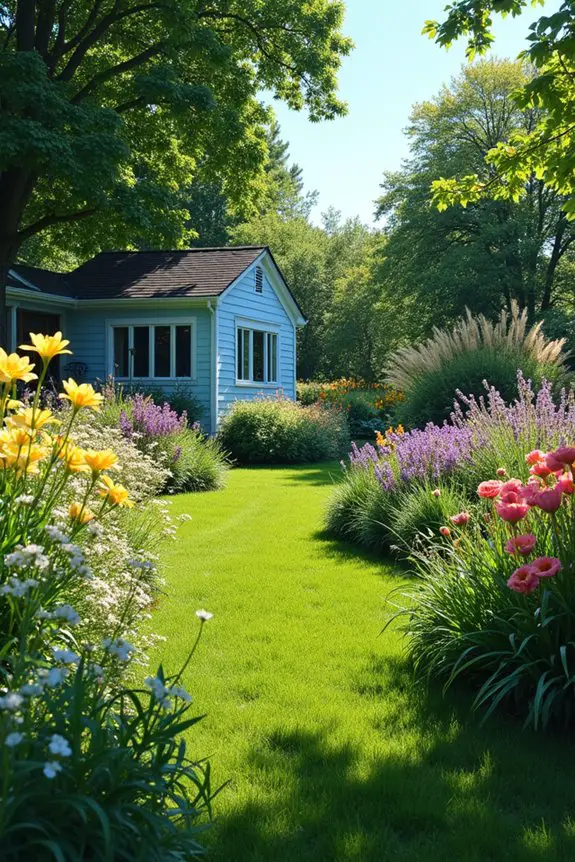
When it comes to designing a garden that truly resonates with its environment, color palette harmony is key. It’s all about creating a seamless blend of hues that feels both inviting and serene. Not only does a well-thought-out color scheme enhance the overall vibe of your outdoor space, but it can also influence the energy of the garden, guiding your eye and warming your spirit.
To start, consider the colors of your home. Choose shades that complement or contrast delightfully with your exterior. For instance, if your house is a cool blue, think about incorporating soft yellows and greens in your plant selections. These colors not only create a beautiful visual experience, but they also soothe the soul. Imagine stepping into your garden and feeling the gentle balance of colors envelop you, like a warm hug from nature.
Next, dive deeper into your plant choices. Native plants are wonderful for this, as they not only support local ecosystems but often come with a palette that’s perfect for your climate. Choose a mix of flowers that bloom at different times of the year. This way, you’ll have a vibrant display from spring to fall, with colors shifting like a beautiful gradient across the seasons. It’s like nature’s own color wheel, spinning joyfully as each flower takes its turn to shine.
And let’s not forget about textures! Plants with varying shapes and leaf colors can enhance your color palette greatly. Think about contrasting deep green leaves with vibrant pink blooms or the delicate white flowers of an ornamental shrub.
Additionally, consider incorporating shade tolerant grass seed into your garden design to create lush green areas that can thrive in less sunlight. It’s a delightful surprise, and it punctuates the garden much like sprinkles on a cupcake.
5. Water-Conserving Landscape Techniques
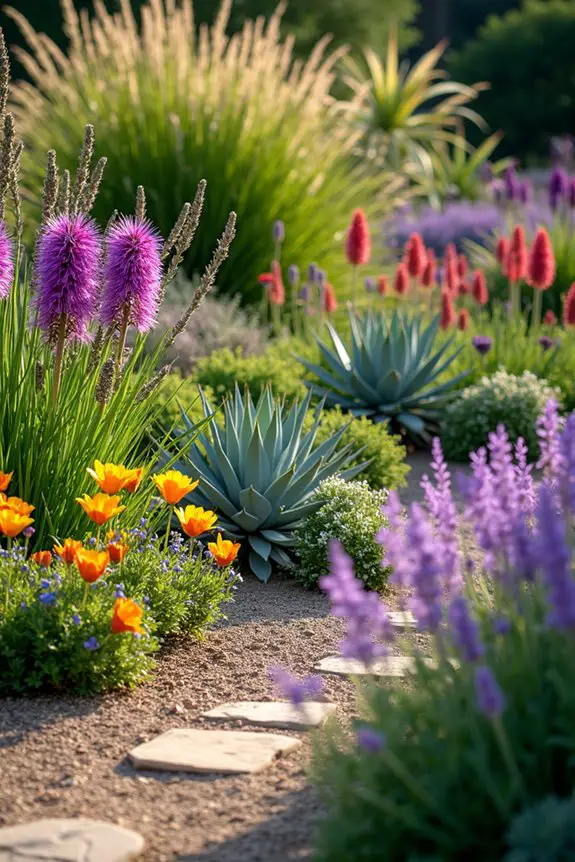
When it comes to creating a water-conserving garden, selecting the right plants can be a game-changer. Not only do eco-friendly plants look great, but they really know how to thrive on less water while giving off an air of relaxed sophistication.
Imagine stepping into a space filled with vibrant colors and textures, all thriving with minimal effort. That’s the magic of sustainable plant selection.
So, here’s a little tip: start with native plants. These beauties have adapted to your local climate and need less water than their non-native cousins. Plus, they attract butterflies and bees, adding life to your garden—how cool is that?
Picture yourself sipping iced tea while colorful butterflies flit about, making your garden feel like a serene oasis.
Next, think about layering your plant heights. Place taller plants at the back and shorter ones in front, creating a lovely visual flow. Go for a mix of shapes, too. An upright plant next to a cascading one can create a dance of textures, making your garden look lush without all the work.
It’s like a well-coordinated dance party, and trust me, even if you can’t dance, your plants can.
And let’s not overlook the fun part—getting your hands dirty. When planting, mix in some drought-tolerant varieties. These resilient guys are tough cookies, able to weather dry spells without breaking a sweat.
And as a bonus, they often have stunning blooms that stand out even in the harshest conditions.
Creating a water-conserving landscape is all about choosing the right performers for your garden’s stage. You want stars that shine bright, need minimal care, and give back to Mother Earth.
6. Textured Plant Composition
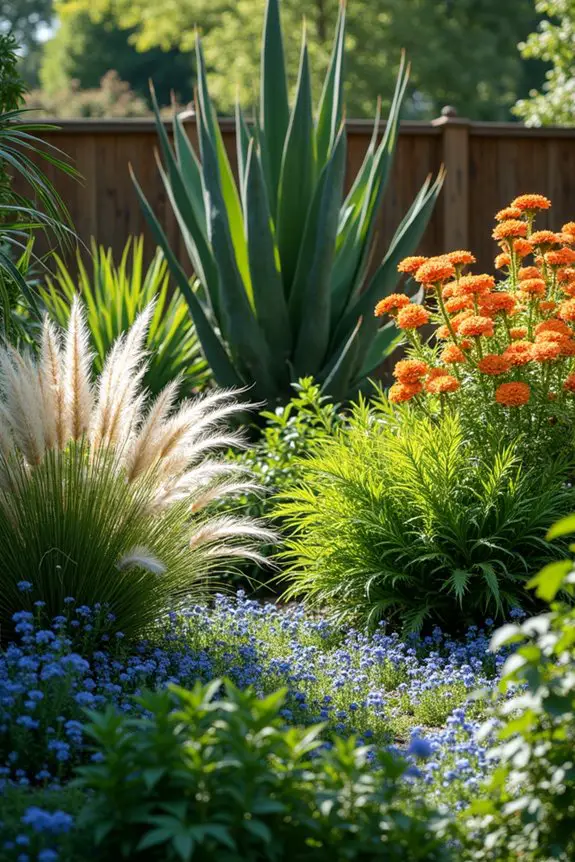
When it comes to creating a beautiful garden, textured plant composition is key. Not only does it add visual interest and depth to your space, but it also creates a lively atmosphere that beckons people to admire its beauty. Imagine this: a riot of colors and textures, from crispy grasses swaying in the breeze to velvety leaves inviting you to touch them. Isn’t that just dreamy?
To get started, pick a mix of plants that offer contrasting textures. Think of combining the sharp edges of spiky plants with the soft, fluffy touches of ferns or ornamental grasses. It’s like inviting a few extroverted friends to join your more introverted pals at a party; the energy mixes beautifully.
A bold statement plant, like a tall yucca, can serve as a centerpiece while smaller, delicate plants dance around it, creating that layered texture you’re going for.
And let’s not forget about color! Textured compositions work best when you choose a palette that complements the vibe of your garden. If you’re going for a calm sanctuary feel, stick to cool greens, shimmery whites, and soft blues. But if you want something more vibrant and lively, toss in splashes of fiery oranges or sunny yellows.
Just remember, harmony is key—too many loud colors can turn your event into a raucous college frat party, and nobody wants that chaos in their garden.
Then overlay, spiral, or cluster your plants. Layer your plants so the smaller ones peek out from behind the taller ones. This creates a gorgeous visual flow that’s appealing to the eye and often leads to a “wow” moment for guests. Instead of a flat garden that resembles a pancake, you’ll have delightful hills and valleys that draw everyone in.
Once you’ve got your textures and colors lined up, think about how each plant interacts with the light. Some plants thrive in bright sunlight while others prefer shade. Mixing them up can create delightful shadows and light play, almost like the sun is designing its own masterpiece.
7. Plant Layering Strategies
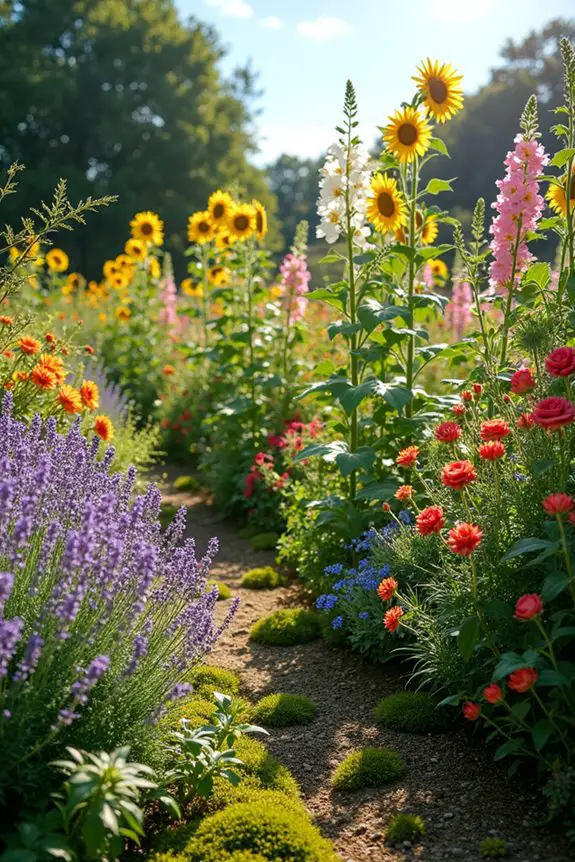
Let’s talk about plant layering—it’s like the delicious lasagna of garden design. You create depth, texture, and a yummy visual feast for the eyes. But the twist? You’re also making eco-friendly choices that help our planet. By selecting climate-appropriate plants, you’re not just sprucing up your space; you’re also keeping your garden low-maintenance and resource-efficient.
First off, think of your garden as a vertical playground. You want tall plants that stand proud in the back, medium-sized showstoppers in the middle, and those delightful little groundcovers that hug the earth at the front.
It’s like inviting your tallest friend to stand at the back of a group picture—no one wants to be blocked out. So, add some towering sunflowers or elegant hollyhocks at the back, then bring in some charming lavender or daylilies to the middle, and let some creeping thyme or colorful sedums lazily drape down in front.
Now, how do you choose eco-friendly plants that play nice together? Research what’s native to your area. Native plants not only thrive in your local climate but also attract birds, bees, and butterflies—nature’s little helpers.
Imagine a garden that buzzes with life, buzzing with colors and scents. You can plant “Bumblebee Buttercup” (a nickname I made up, but wouldn’t that be cute?) alongside cheerful coneflowers to create a vibrant wildlife haven.
Don’t forget to compliment each layer with those contrasting textures we discussed. Pair prickly thistles with soft pool of moss or silky grasses for that fabulous visual pop.
And let’s talk about color—create a cohesive color theme that feels as comfy as a favorite sweatshirt. Muted greens paired with the soft blush of roses can evoke tranquility, while a burst of fiery oranges and vibrant yellows makes for an attention-grabbing celebration.
Finally, remember to stagger your plants. It sounds fancy, but it’s really just playing a game of hide-and-seek with your greens.
Alternating heights and textures adds movement to your garden, like a flowing dance—but without the awkward moments where someone steps on each other’s toes. Trust me, that’s not a scene we want to relive.
8. Visual Balance in Gardens
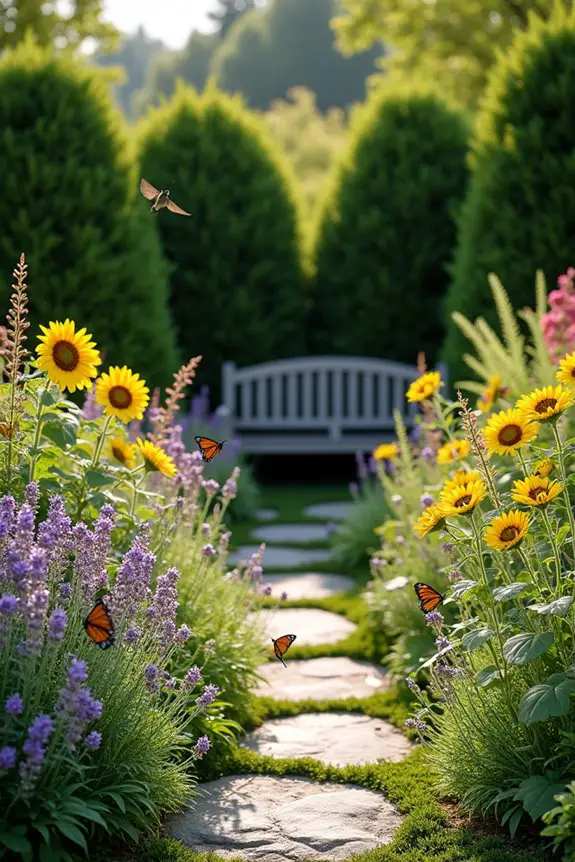
Creating visual balance in your garden is all about harmony. It’s like preparing a meal where every dish complements the flavors on your plate. You want your plants to work together, creating an aesthetically pleasing environment that feels peaceful while also doing its part for the planet. Envision this as a scholarly gathering of plants, where everyone plays a role in creating that eco-friendly vibe.
Start with the idea of symmetry. Symmetrical planting can lend a calm, ordered structure to your outdoor space. Envision this: on one side, you’ve got a row of delicate ferns gracefully stretching upwards, while the other side matches them with an equally elegant display of native wildflowers. It reduces chaos and embraces that soothing look often found in modern minimalist gardens.
Next, consider the vibrancy of color. Picking a palette is like choosing the perfect toppings for your pizza. You want some cool greens paired with warm yellows or pinks—never just plain old cheese. For instance, pair the deep, lush green hues of native shrubs with bursts of cheerful lavender and bright sunflowers. This combo not only adds depth but also attracts bees and birds, increasing the charm of your garden.
Now, let’s talk about layers. Just like you wouldn’t serve a flat, one-dimensional lasagna, you don’t want your garden looking flat. So, use taller plants at the back and smaller ones in the front, allowing each plant to shine. Think of it as creating a tiered dessert, where each layer entices you in its own special way. Don’t forget to use textured plants—like soft moss paired with strappy reeds—to make your garden visually stunning.
Remember, this is also about choosing plants that thrive together and support local wildlife while being easy on the eyes. Research what’s native to your area—you’ll find that these plants are used to the local climate, so they’ll make your garden look great without the fuss of constant watering or complicated treatments. Together, they’ll create a vibrant haven full of color, texture, and life.
Finally, embrace movement. Staggering your plants creates a sense of action and flow, almost like a dance floor where every plant has its groove. Think of those little creeping thyme plants elegantly cascading over stones, inviting you to come closer. It’s all about balance, rhythm, and keeping things lively, reminding you that nature is a bit of a show-off in the best possible way.
With these tips, your garden can’t only look amazing but also serenade your senses—and, trust me, nothing boosts your garden’s visual appeal like a successfully balanced design.
9. Garden Pathway Layout

Creating a garden pathway is like laying out a delicious buffet—not just a way to get from point A to point B, but a fabulous journey! Your pathway can guide visitors through your garden paradise, showcasing the delightful plants along the way. Plus, selecting eco-friendly plants guarantees that your garden is both beautiful and kind to the environment. It’s the best of both worlds!
First off, think about the materials for your pathway. You can go organic with natural stone, reclaimed wood, or even crushed gravel. These options create a charming rustic vibe that’s easier on the eyes. Imagine walking on a smooth slate path that curves gently through a sea of blooming native flowers. Doesn’t that just make you want to take a big, deep inhale of invigorating air?
Now, when we plunge into the plants, select native species that will thrive in your local climate. It’s a bit like starring in your own cooking show—only using ingredients that are fresh and local. Plants like bee balm and goldenrod not only thrive on minimal water but also invite pollinators to your party. Who wouldn’t want bees buzzing around, adding a touch of sweet music to your garden?
Next, think about spacing. Much like arranging your dinner plate, you need to give each plant some room to shine. Place taller plants like sunflowers towards the back of the pathway and layer them with shorter ones in the front. This way, every vibrant color and texture is visible, just waiting to dazzle its guests. And remember, lush greenery can act as the perfect backdrop, enhancing the whole experience.
Want to make it even cozier? Add little spots to rest along the way. Think of a bench nestled among aromatic herbs like rosemary or lavender. Not only does it create a perfect place for a sunny day’s sip of lemonade, but the fragrances mingle seamlessly, transforming your garden into an aromatic haven. Close your eyes, can you smell it? Heaven!
Lastly, don’t forget to incorporate lighting. Soft, low-voltage lights running along the path can create a whimsical nighttime ambiance. Imagine strolling through a star-lit garden where your plants glow softly in the moonlight. It’s like inviting your garden on a date. Just you, the plants, and a beautiful pathway leading the way.
With these little touches, your garden pathway will be much more than just a walkway; it’ll be an adventure waiting to unfold. Mother Nature will surely thank you as you create a supportive and stunning oasis that benefits both the environment and your senses. So, grab your shovel, and let’s get gardening!
10. Spatial Flow Enhancement
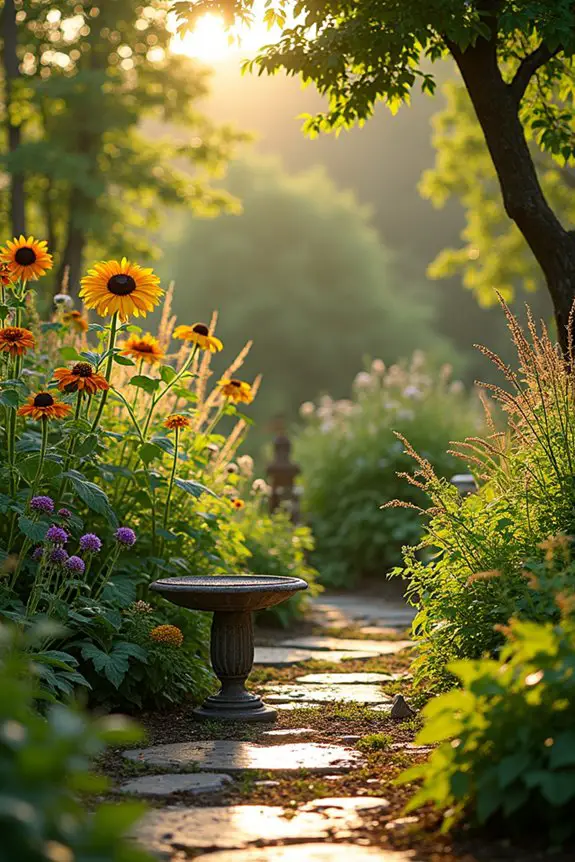
When it comes to creating a seamless spatial flow in your garden, eco-friendly plant selection is the way to go. Not only does it support the environment, but it also sets a lovely vibe that makes your outdoor space feel warm and inviting. Imagine walking through a garden bustling with life, where every plant helps your little ecosystem thrive—how amazing is that?
To start, pick native plants that are like the friendly neighbors of your garden—you know, the ones who keep their yards tidy and wave hello as you pass by. Plants like echinacea and butterfly weed are perfect because they’re not just pretty faces; they attract pollinators while needing minimal care. Talk about winning on all fronts! Plus, they’ll look stunning as they sway in the breeze, adding a natural rhythm to your garden.
Now, spacing is everything. If you cram your plants together like sardines in a can, they won’t have room to breathe—or grow. Instead, arrange them based on height, shading one another just right. Taller plants at the back, shorter ones up front—it’s like hosting a talent show where you want the headliners to shine in the spotlight! Or as I like to think, give your sunflowers the chandelier effect they deserve.
Consider layering your plants too. Imagine a delightful lasagna of greenery where textures and colors intertwine, creating a mouthwatering view. Combine soft grasses with spiky flowers to add depth and dimension. Just remember, a little variety spices things up, keeping your guests engaged on their stroll through your garden.
Want to make it even friendlier? Add some edible plants, like herbs or cherry tomatoes, scattered throughout. They’re not only useful, but they also give that homey feel—as if you’ve invited your family over for dinner! You can just imagine plucking a few leaves of basil or munching on a sweet tomato while soaking up the garden vibes. Cooking with garden goodies? That’s a chef’s dream right there.
And finally, don’t skimp on those quirky little details. Whether it’s placing a few rustic pots around, or even an elegant birdbath to attract feathered friends, these small touches will have your space oozing personality, making it an enjoyable spot to unwind. Your garden won’t only look fabulous but feel like a cozy retreat that invites you to sit back and relax.
The result? A beautifully flowing garden bursting with life, laughter, and a sprinkle of nature’s magic.
Seasonal Plant Rotation Strategies
If you’ve ever stared at a garden plot wondering why your summer flowers look a little sad come fall, you’re not alone.
The secret’s in seasonal plant rotation. Think of it like giving your soil a fresh batch of ingredients. Start by designing a garden layout that allows for easy changes.
Seasonal plant rotation is your soil’s best friend—refresh it with new blooms to keep your garden thriving!
When autumn arrives, pull out those wilting blooms and replace them with hardy winter plants that thrive in cooler temps. You can even mix in containers for a pop of color!
After all, who wants a sad garden? By planning ahead, you guarantee your outdoor space looks lively all year long.
It’s like a never-ending garden party, just with fewer awkward small talk moments. Happy planting!

